Variations in Growing-Season NDVI and Its Response to Permafrost Degradation in Northeast China
Abstract
:1. Introduction
2. Materials and Methods
2.1. Study Area
2.2. NDVI Datasets
2.3. Ground Surface Temperature Data
2.4. Methods
2.4.1. Consistency Checking Between LTDR and MODIS Datasets
2.4.2. Spatiotemporal Analysis for NDVI and GST
3. Results and Discussion
3.1. Consistency Check
3.2. The Interannual Dynamics of MGS-NDVI and Its Correlation to GS-MGST at the Scale of the Entire Permafrost Zone
3.3. Spatial Dynamics of MGS-NDVI and Its Relationship to GS-MGST at the Pixel Scale
3.4. Changes in MGS-NDVI and Its Association with GS-MGST in Different Types of Permafrost Zones
4. Conclusions
- (1)
- The MGS-NDVI significantly increased at a rate of 0.003 year−1 at the entire permafrost zone scale. Meanwhile, the spatial dynamics of the vegetation cover in the permafrost zone had a high degree of heterogeneity at the per pixel scale.
- (2)
- These results suggest that warming GS-MGST (permafrost degradation) in the permafrost region of northeastern China played a positive role in improving plant growth and increasing plant activity. However, increasing ground surface temperature accelerated vegetation cover and growth in the short term with permafrost degradation; nevertheless, from a long term point of view, permafrost degradation or its disappearance may weaken or even hinder vegetation growth and activity.
Acknowledgments
Author Contributions
Conflicts of Interest
Abbreviations
| NDVI | Normalization Difference Vegetation Index |
| GST | Ground surface temperature |
| NASA | National Aeronautics and Space Administration |
| AVHRR | Advanced Very High Resolution Radiometer |
| MODIS | Moderate Resolution Imaging Radiometer |
| LTDR | Long Term Data Record |
| GIMMS | Global Inventory Modelling and Mapping Studies |
| CP | Continuous permafrost |
| DIP | Discontinuous permafrost with island taliks |
| SIP | Sparse island permafrost |
| MGS-NDVI | Mean growing-season Normalization Difference Vegetation Index |
| GS-MGST | Growing-season mean ground surface temperature |
| MVC | Maximum value composite |
References
- Ran, Y.H.; Li, X.; Cheng, G.D.; Zhang, T.J.; Wu, Q.B.; Jin, H.J.; Jin, R. Distribution of permafrost in China: An overview of existing permafrost maps. Permafr. Periglac. Process. 2012, 23, 322–333. [Google Scholar] [CrossRef]
- Schuur, E.A.G.; Bockheim, J.; Canadell, J.G.; Euskirchen, E.; Field, C.B.; Goryachkin, S.V.; Hagemann, S.; Kuhry, P.; Lafleur, P.M.; Lee, H.; et al. Vulnerability of permafrost carbon to climate change: Implications for the global carbon cycle. Bioscience 2008, 58, 701–714. [Google Scholar] [CrossRef]
- Morgenstern, A.; Hauber, E.; Reiss, D.; van Gasselt, S.; Grosse, G.; Schirrmeister, L. Deposition and degradation of a volatile-rich layer in Utopia Planitia and implications for climate history on Mars. J. Geophys. Res. Planets 2007, 112. [Google Scholar] [CrossRef]
- Cheng, G.D.; Wu, T.H. Responses of permafrost to climate change and their environmental significance, Qinghai-Tibet Plateau. J. Geophys. Res. Earth Surf. 2007, 112. [Google Scholar] [CrossRef]
- Guglielmin, M.; Ellis Evans, C.J.; Cannone, N. Active layer thermal regime under different vegetation conditions in permafrost areas. A case study at Signy Island (Maritime Antarctica). Geoderma 2008, 144, 73–85. [Google Scholar] [CrossRef]
- Li, X.; Cheng, G.D. AGIS-aided response model of high-altitude permafrost to global change. Sci. China Ser. D Earth Sci. 1999, 42, 72–79. [Google Scholar]
- Tutubalina, O.V.; Rees, W.G. Vegetation degradation in a permafrost region as seen from space: Noril’sk (1961-1999). Cold Reg. Sci. Technol. 2001, 32, 191–203. [Google Scholar] [CrossRef]
- Yang, Z.; Gao, J.; Zhou, C.; Shi, P.; Zhao, L.; Shen, W.; Ouyang, H. Spatio-temporal changes of NDVI and its relation with climatic variables in the source regions of the Yangtze and Yellow rivers. J. Geogr. Sci. 2011, 21, 979–993. [Google Scholar] [CrossRef]
- Mao, D.; Luo, L.; Wang, Z.; Zhang, C.; Ren, C. Variations in net primary productivity and its relationships with warming climate in the permafrost zone of the Tibetan Plateau. J. Geogr. Sci. 2015, 25, 967–977. [Google Scholar] [CrossRef]
- Hudson, J.M.G.; Henry, G.H.R. Increased plant biomass in a High Arctic heath community from 1981 to 2008. Ecology 2009, 90, 2657–2663. [Google Scholar] [CrossRef] [PubMed]
- Sun, Z.G.; Wang, Q.X.; Xiao, Q.G.; Batkhishig, O.; Watanabe, M. Diverse responses of remotely sensed grassland phenology to interannual climate variability over frozen ground regions in Mongolia. Remote Sens. 2015, 7, 360–377. [Google Scholar] [CrossRef]
- Camill, P.; Lynch, J.A.; Clark, J.S.; Adams, J.B.; Jordan, B. Changes in biomass, aboveground net primary production, and peat accumulation following permafrost thaw in the boreal peatlands of Manitoba, Canada. Ecosystems 2001, 4, 461–478. [Google Scholar] [CrossRef]
- Liu, X.; Zhang, J.; Zhu, X.; Pan, Y.; Liu, Y.; Zhang, D.; Lin, Z. Spatiotemporal changes in vegetation coverage and its driving factors in the Three-river Headwaters Region during 2000–2011. J. Geogr. Sci. 2014, 24, 288–302. [Google Scholar] [CrossRef]
- O’Donnell, J.A.; Jorgenson, M.T.; Harden, J.W.; McGuire, A.D.; Kanevskiy, M.Z.; Wickland, K.P. The effects of permafrost thaw on soil hydrologic, thermal, and carbon dynamics in an Alaskan peatland. Ecosystems 2012, 15, 213–229. [Google Scholar] [CrossRef]
- Chen, S.Y.; Liu, W.J.; Qin, X.; Liu, Y.S.; Zhang, T.Z.; Chen, K.L.; Hu, F.Z.; Ren, J.W.; Qin, D.H. Response characteristics of vegetation and soil environment to permafrost degradation in the upstream regions of the Shule river basin. Environ. Res. Lett. 2012, 7, 11. [Google Scholar] [CrossRef]
- Li, Y.; Guan, D.; Zhao, L.; Gu, S.; Zhao, X. Seasonal Frozen Soil and Its Effect on Vegetation Production in Haibei Alpine Meadow. J. Glaciol. Geocryol. 2005, 27, 311–319. (In Chinese) [Google Scholar]
- Lloyd, A.H.; Yoshikawa, K.; Fastie, C.L.; Hinzman, L.; Fraver, M. Effects of permafrost degradation on woody vegetation at arctic treeline on the Seward Peninsula, Alaska. Permafr. Periglac. Process. 2003, 14, 93–101. [Google Scholar] [CrossRef]
- Tape, K.; Sturm, M.; Racine, C. The evidence for shrub expansion in northern Alaska and the Pan-Arctic. Glob. Chang. Biol. 2006, 12, 686–702. [Google Scholar] [CrossRef]
- Wei, Z.; Jin, H.J.; Zhang, J.M.; Yu, S.P.; Han, X.J.; Ji, Y.J.; He, R.X.; Chang, X.L. Prediction of permafrost changes in Northeastern China under a changing climate. Sci. China Earth Sci. 2011, 54, 924–935. [Google Scholar] [CrossRef]
- Cheng, G.D.; Jin, H.J. Permafrost and groundwater on the Qinghai-Tibet Plateau and in Northeast China. Hydrogeol. J. 2013, 21, 5–23. [Google Scholar] [CrossRef]
- Jin, H.J.; Li, S.X.; Cheng, G.D.; Wang, S.L.; Li, X. Permafrost and climatic change in China. Glob. Planet. Chang. 2000, 26, 387–404. [Google Scholar] [CrossRef]
- Li, X.; Cheng, G.D.; Jin, H.J.; Kang, E.; Che, T.; Jin, R.; Wu, L.Z.; Nan, Z.T.; Wang, J.; Shen, Y.P. Cryospheric change in China. Glob. Planet. Chang. 2008, 62, 210–218. [Google Scholar] [CrossRef]
- Jin, H.J.; Yu, Q.H.; Lii, L.Z.; Guo, D.X.; He, R.X.; Yu, S.P.; Sun, G.Y.; Li, Y.W. Degradation of permafrost in the Xing’anling Mountains, Northeastern China. Permafr. Periglac. Process. 2007, 18, 245–258. [Google Scholar] [CrossRef]
- Guo, J.T.; Han, F.L.; Bu, R.C.; Hu, Y.M.; Ma, J.; Nie, Z.W.; Zhu, J.L.; Ren, B.H. Classification of plant communities and species diversity responses to changes in the permafrost depths of the north slope of the Great Khingan Mountain valley of Northeast China. Acta Ecol. Sin. 2016, 36, 1–8. (In Chinese) [Google Scholar] [CrossRef]
- Sun, J.; Li, X.Z.; Wang, X.W.; Lu, J.J.; Li, Z.M. Plant species distribution in permafrost wetlands of the Great Hing’an Mountain valleys and its response to global climate change. J. Earth Sci. 2010, 21, 266–270. [Google Scholar] [CrossRef]
- Bockheim, J.; Vieira, G.; Ramos, M.; Lopez-Martinez, J.; Serrano, E.; Guglielmin, M.; Wilhelm, K.; Nieuwendam, A. Climate warming and permafrost dynamics in the Antarctic Peninsula region. Glob. Planet. Chang. 2013, 100, 215–223. [Google Scholar] [CrossRef]
- Westermann, S.; Langer, M.; Boike, J. Spatial and temporal variations of summer surface temperatures of high-arctic tundra on Svalbard—Implications for MODIS LST based permafrost monitoring. Remote Sens. Environ. 2011, 115, 908–922. [Google Scholar] [CrossRef]
- Editorial Board of Vegetation Map of China, Chinese Academy of Sciences (EBVMC). Vegetation Atlas of China; Science Press: Beijing, China, 2001. (In Chinese) [Google Scholar]
- Jin, H.; Sun, G.; Yu, S.; Jin, R.; He, R. Symbiosis of Marshes and Permafrost in Da and Xiao Hinggan Mountains in Northeastern China. Chin. Geogr. Sci. 2008, 18, 62–69. [Google Scholar] [CrossRef]
- Sjöberg, Y.; Marklund, P.; Pettersson, R.; Lyon, S.W. Geophysical mapping of palsa peatland permafrost. Cryosphere 2015, 9, 465–478. [Google Scholar] [CrossRef]
- Guo, D.X.; Wang, S.L.; Lu, G.W.; Dai, J.B.; Li, E.Y. Zonation of permafrost in the Da and Xiao Xing’anling mountains in Northeastern China. J. Glaciol. Geocryol. 1981, 3, 1–9. (In Chinese) [Google Scholar]
- Kidwell, K.B. NOAA Polar Orbiter Data User’s Guide (TIROS-N, NOAA-6, NOAA-7, NOAA-8, NOAA-9, NOAA-10, NOAA-11, NOAA-12, NOAA-13 and NOAA-14). Available online: http://www.ncdc.noaa.gov/oa/pod-guide/ncdc/docs/podug/index.htm (accessed on 1 April 2016).
- Sun, W.; Song, X.; Mu, X.; Gao, P.; Wang, F.; Zhao, G. Spatiotemporal vegetation cover variations associated with climate change and ecological restoration in the Loess Plateau. Agric. For. Meteorol. 2015, 209, 87–99. [Google Scholar] [CrossRef]
- Pedelty, J.; Devadiga, S.; Masuoka, E.; Brown, M.; Pinzon, J.; Tucker, C.; Vermote, E.; Prince, S.; Nagol, J.; Justice, C.; et al. Generating a long-term land data record from the AVHRR and MODIS instruments. Proceeding of the IEEE International Geoscience and Remote Sensing Symposium (IGARSS), Barcelona, Spain, 23–28 July 2007; pp. 1021–1025. [Google Scholar]
- Fensholt, R.; Proud, S.R. Evaluation of earth observation based global long term vegetation trends—Comparing GIMMS and MODIS global NDVI time series. Remote Sens. Environ. 2012, 119, 131–147. [Google Scholar] [CrossRef]
- Guo, M.; Wang, X.; Li, J.; Yi, K.; Zhong, G.; Tani, H. Assessment of global carbon dioxide concentration using MODIS and GOSAT data. Sensors 2012, 12, 16368. [Google Scholar] [CrossRef] [PubMed]
- Solano, R.; Didan, K.; Jacobson, A.; Huete, A. MODIS Vegetation Indices (MOD13) C5 User’s Guide. Available online: http://tbrs.arizona.edu/project/MODIS/UsersGuide.pdf (accessed on 1 April 2016).
- Chang, T.; Xiong, X.; Angal, A.; Mu, Q. Assessment of MODIS RSB detector uniformity using deep convective clouds. J. Geophys. Res. Atmos. 2016, 121, 4783–4796. [Google Scholar] [CrossRef]
- Holben, B.N. Characteristics of maximum-value composite images from temporal AVHRR data. Int. J. Remote Sens. 1986, 7, 1417–1434. [Google Scholar] [CrossRef]
- Huete, A.; Didan, K.; Miura, T.; Rodriguez, E.P.; Gao, X.; Ferreira, L.G. Overview of the radiometric and biophysical performance of the MODIS vegetation indices. Remote Sens. Environ. 2002, 83, 195–213. [Google Scholar] [CrossRef]
- Liu, X.; Zhu, X.; Li, S.; Liu, Y.; Pan, Y. Changes in growing season vegetation and their associated driving forces in China during 2001–2012. Remote Sens. 2015, 7, 15517–15535. [Google Scholar] [CrossRef]
- Steven, M.D.; Malthus, T.J.; Baret, F.; Xu, H.; Chopping, M.J. Intercalibration of vegetation indices from different sensor systems. Remote Sens. Environ. 2003, 88, 412–422. [Google Scholar] [CrossRef]
- Bao, G.; Qin, Z.H.; Bao, Y.H.; Zhou, Y.; Li, W.J.; Sanjjav, A. NDVI-based long-term vegetation dynamics and its response to climatic change in the Mongolian Plateau. Remote Sens. 2014, 6, 8337–8358. [Google Scholar] [CrossRef]
- Stow, D.; Daeschner, S.; Hope, A.; Douglas, D.; Petersen, A.; Myneni, R.; Zhou, L.; Oechel, W. Variability of the seasonally integrated normalized difference vegetation index across the north slope of Alaska in the 1990s. Int. J. Remote Sens. 2003, 24, 1111–1117. [Google Scholar] [CrossRef]
- Herrmann, S.M.; Anyamba, A.; Tucker, C.J. Recent trends in vegetation dynamics in the African Sahel and their relationship to climate. Glob. Environ. Chang. Hum. Policy Dimens. 2005, 15, 394–404. [Google Scholar] [CrossRef]
- Chen, H.; Zhu, Q.; Peng, C.; Wu, N.; Wang, Y.; Fang, X.; Gao, Y.; Zhu, D.; Yang, G.; Tian, J.; et al. The impacts of climate change and human activities on biogeochemical cycles on the Qinghai-Tibetan Plateau. Glob. Chang. Biol. 2013, 19, 2940–2955. [Google Scholar] [CrossRef] [PubMed]
- Kelley, A.M.; Epstein, H.E.; Walker, D.A. Role of vegetation and climate in permafrost active layer depth in arctic tundra of northern Alaska and Canada. J. Glaciol. Geocryol. 2004, 26, 269–274. [Google Scholar]
- Schuur, E.A.G.; Crummer, K.G.; Vogel, J.G.; Mack, M.C. Plant species composition and productivity following permafrost thaw and thermokarst in Alaskan tundra. Ecosystems 2007, 10, 280–292. [Google Scholar] [CrossRef]
- Zhuang, Q.; McGuire, A.D.; Melillo, J.M.; Clein, J.S.; Dargaville, R.J.; Kicklighter, D.W.; Myneni, R.B.; Dong, J.; Romanovsky, V.E.; Harden, J.; et al. Carbon cycling in extratropical terrestrial ecosystems of the Northern Hemisphere during the 20th century: A modeling analysis of the influences of soil thermal dynamics. Tellus B 2003, 55, 751–776. [Google Scholar] [CrossRef]
- Guo, Z.G.; Niu, F.J.; Zhan, H.; Wu, Q.B. Changes of grassland ecosystem due to degradation of permafrost frozen soil in the Qinghai-Tibet Plateau. Acta Ecol. Sin. 2007, 27, 3294–3301. (In Chinese) [Google Scholar]
- Wang, S.L.; Jin, H.J.; Li, S.X.; Zhao, L. Permafrost degradation on the Qinghai-Tibet Plateau and its environmental impacts. Permafr. Perigla. Process. 2000, 11, 43–53. [Google Scholar]
- Wang, Z.; Yang, G.; Yi, S.; Wu, Z.; Guan, J.; He, X.; Ye, B. Different response of vegetation to permafrost change in semi-arid and semi-humid regions in Qinghai-Tibetan Plateau. Environ. Earth Sci. 2012, 66, 985–991. [Google Scholar]
- Piao, S.L.; Fang, J.Y.; Ji, W.; Guo, Q.H.; Ke, J.H.; Tao, S. Variation in a satellite-based vegetation index in relation to climate in China. J. Veg. Sci. 2004, 15, 219–226. [Google Scholar] [CrossRef]
- Jeong, S.J.; Ho, C.H.; Gim, H.J.; Brown, M.E. Phenology shifts at start vs. End of growing season in temperate vegetation over the Northern Hemisphere for the period 1982-2008. Glob. Chang. Biol. 2011, 17, 2385–2399. [Google Scholar] [CrossRef]
- Los, S.O.; Collatz, G.J.; Bounoua, L.; Sellers, P.J.; Tucker, C.J. Global interannual variations in sea surface temperature and land surface vegetation, air temperature, and precipitation. J. Clim. 2001, 14, 1535–1549. [Google Scholar] [CrossRef]
- Myneni, R.B.; Keeling, C.D.; Tucker, C.J.; Asrar, G.; Nemani, R.R. Increased plant growth in the northern high latitudes from 1981 to 1991. Nature 1997, 386, 698–702. [Google Scholar] [CrossRef]
- Xu, L.; Myneni, R.B.; Chapin, F.S., III; Callaghan, T.V.; Pinzon, J.E.; Tucker, C.J.; Zhu, Z.; Bi, J.; Ciais, P.; Tommervik, H.; et al. Temperature and vegetation seasonality diminishment over northern lands. Nat. Clim. Chang. 2013, 3, 581–586. [Google Scholar] [CrossRef]
- Piao, S.; Nan, H.; Huntingford, C.; Ciais, P.; Friedlingstein, P.; Sitch, S.; Peng, S.; Ahlstrom, A.; Canadell, J.G.; Cong, N.; et al. Evidence for a weakening relationship between interannual temperature variability and northern vegetation activity. Nat. Commun. 2014, 5, 1–7. [Google Scholar] [CrossRef] [PubMed]
- Mao, D.; Wang, Z.; Luo, L.; Ren, C. Integrating AVHRR and MODIS data to monitor NDVI changes and their relationships with climatic parameters in Northeast China. Int. J. Appl. Earth Obs. 2012, 18, 528–536. [Google Scholar] [CrossRef]
- Yi, S.H.; Zhou, Z.Y.; Ren, S.L.; Xu, M.; Qin, Y.; Chen, S.Y.; Ye, B.S. Effects of permafrost degradation on alpine grassland in a semi-arid basin on the Qinghai-Tibetan Plateau. Environ. Res. Lett. 2011, 6, 7. [Google Scholar] [CrossRef]
- Peng, X.; Wu, Q.; Tian, M. The effect of groundwater table lowering on ecological environment in the headwaters for the yellow river. J. Glaciol. Geocryol. 2003, 25, 667–671. [Google Scholar]
- Zhang, S.; Wang, Y.; Zhao, Y.; Huang, Y.; Li, Y.; Shi, W.; Shang, X. Permafrost degradation and its environmental sequent in the source regions of the yellow river. J. Glaciol. Geocryol. 2004, 26, 1–6. [Google Scholar]
- Daniel, J.H.; David, W.K.; McGuire, A.D.; Min, C.; Qianlai, Z.; Fengming, Y.; Jerry, M.M.; Stan, D.W. The impacts of recent permafrost thaw on land–atmosphere greenhouse gas exchange. Environ. Res. Lett. 2014, 9, 1–12. [Google Scholar]
- Schaefer, K.; Lantuit, H.; Romanovsky, V.E.; Schuur, E.A.G.; Witt, R. The impact of the permafrost carbon feedback on global climate. Environ. Res. Lett. 2014, 9, 9. [Google Scholar] [CrossRef]
- Schuur, E.A.G.; McGuire, A.D.; Schadel, C.; Grosse, G.; Harden, J.W.; Hayes, D.J.; Hugelius, G.; Koven, C.D.; Kuhry, P.; Lawrence, D.M.; et al. Climate change and the permafrost carbon feedback. Nature 2015, 520, 171–179. [Google Scholar] [CrossRef] [PubMed]
- Zimov, S.A.; Schuur, E.A.G.; Chapin, F.S. Permafrost and the global carbon budget. Science 2006, 312, 1612–1613. [Google Scholar] [CrossRef] [PubMed]
- Qian, H.; Joseph, R.; Zeng, N. Enhanced terrestrial carbon uptake in the northern high latitudes in the 21st century from the coupled carbon cycle climate model intercomparison project model projections. Glob. Chang. Biol. 2010, 16, 641–656. [Google Scholar] [CrossRef]
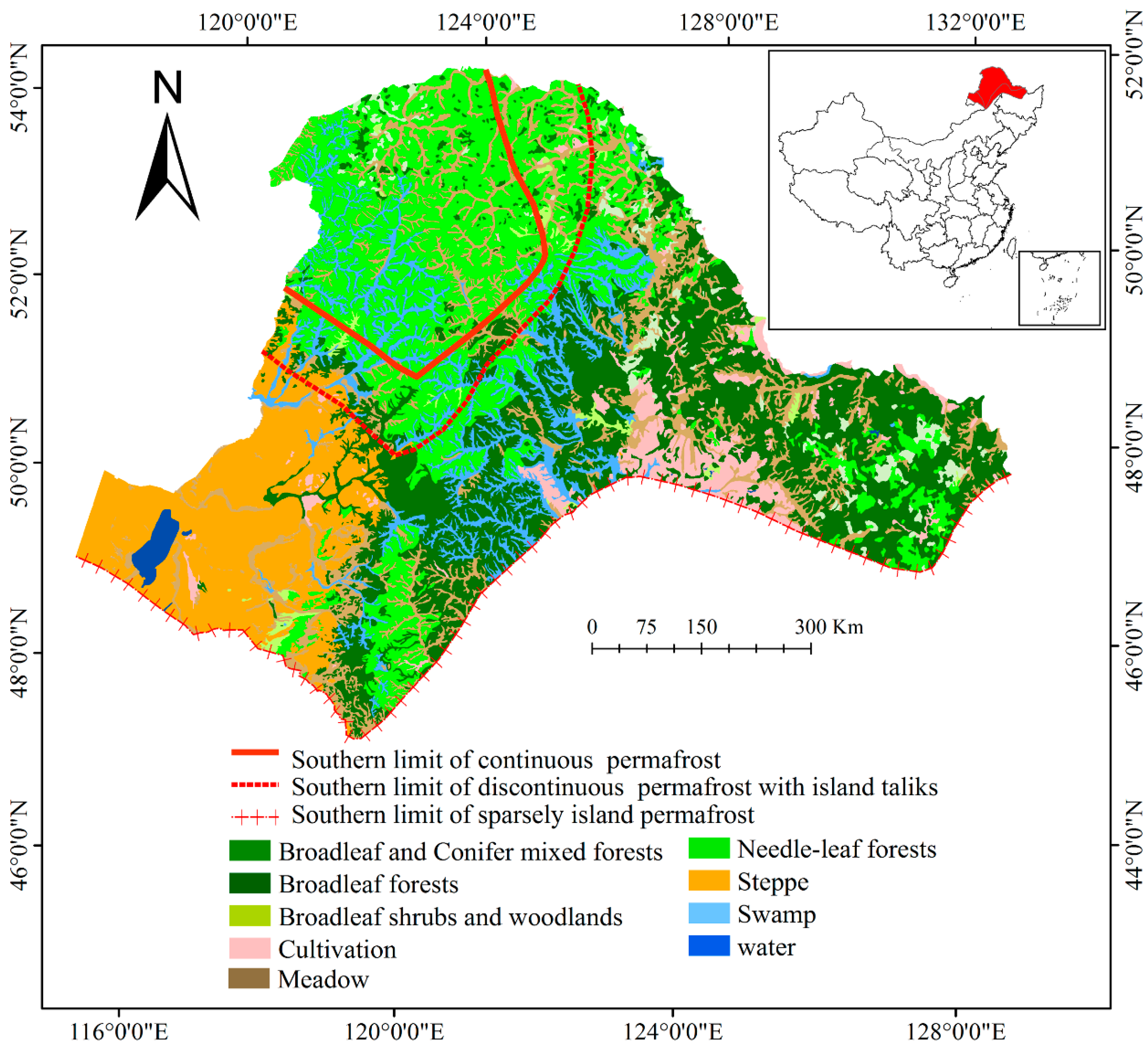
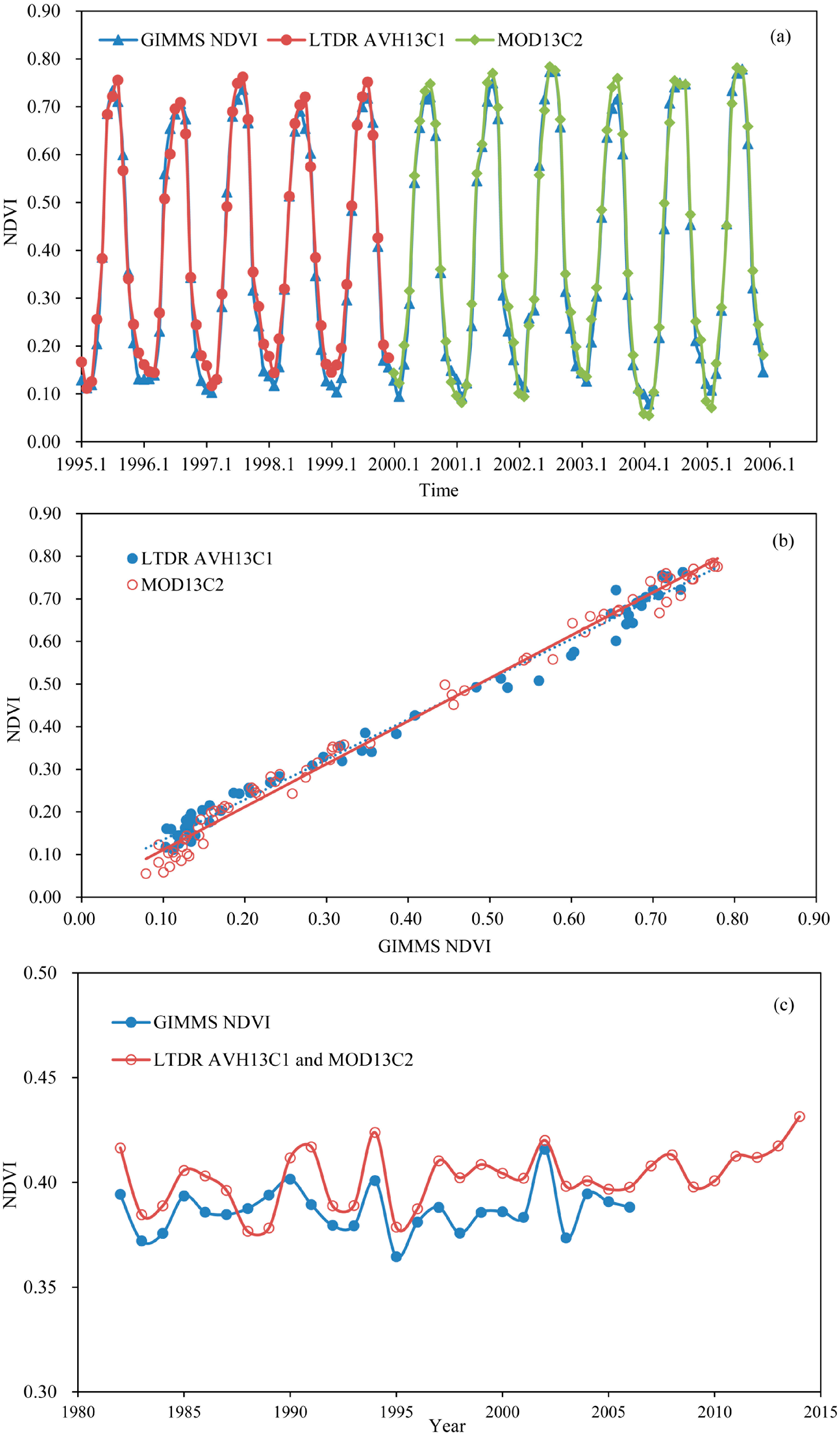
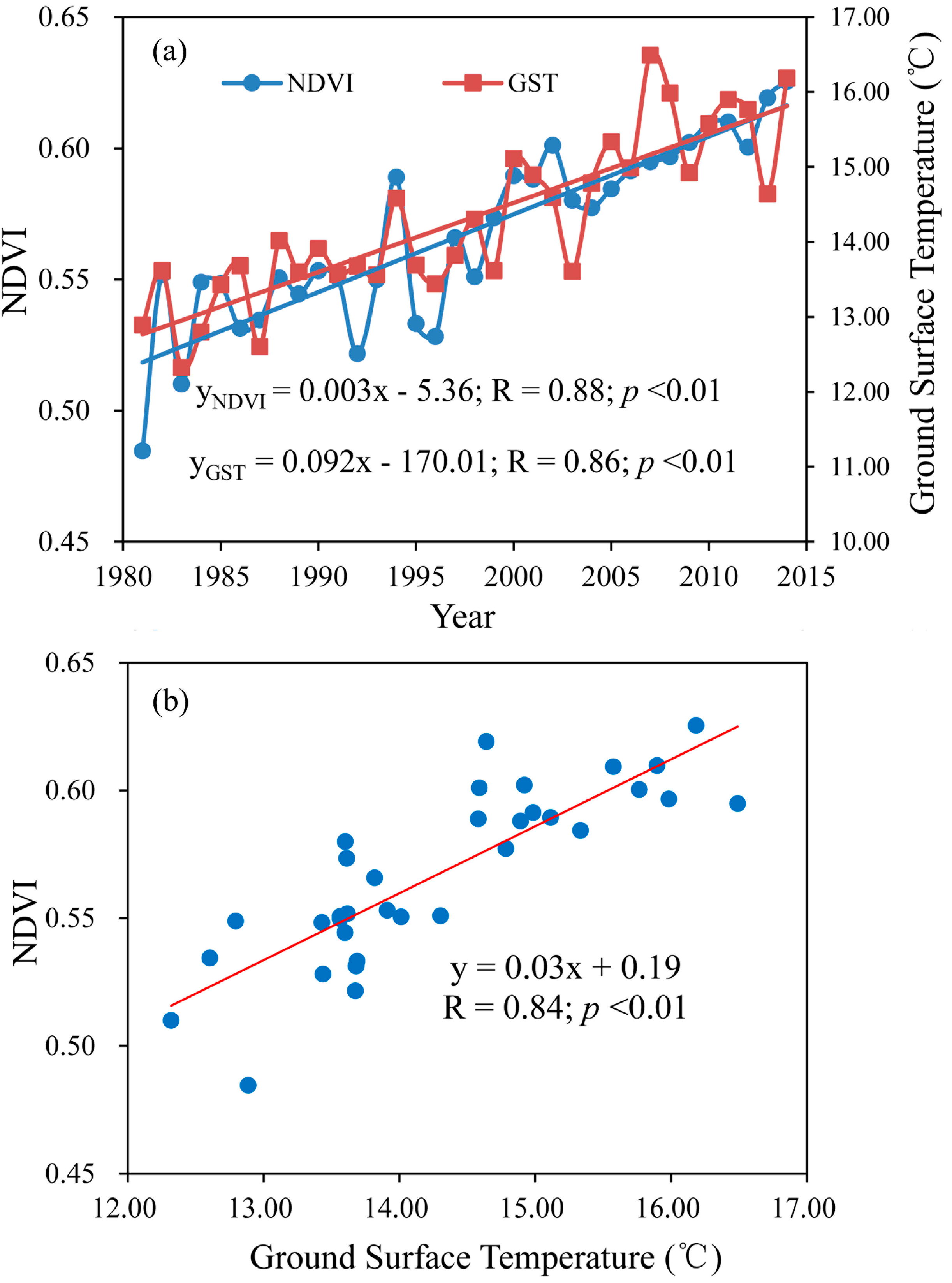
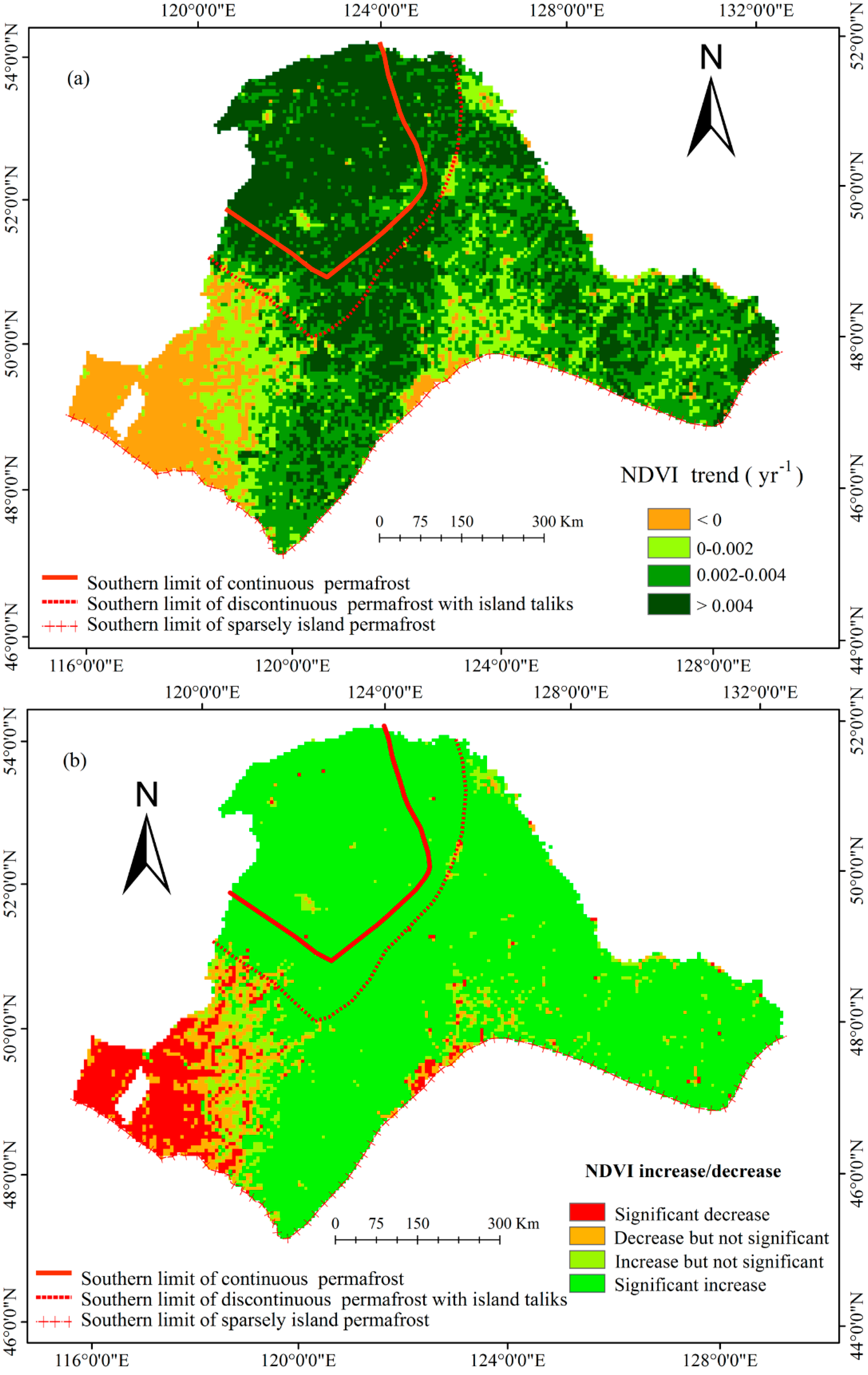
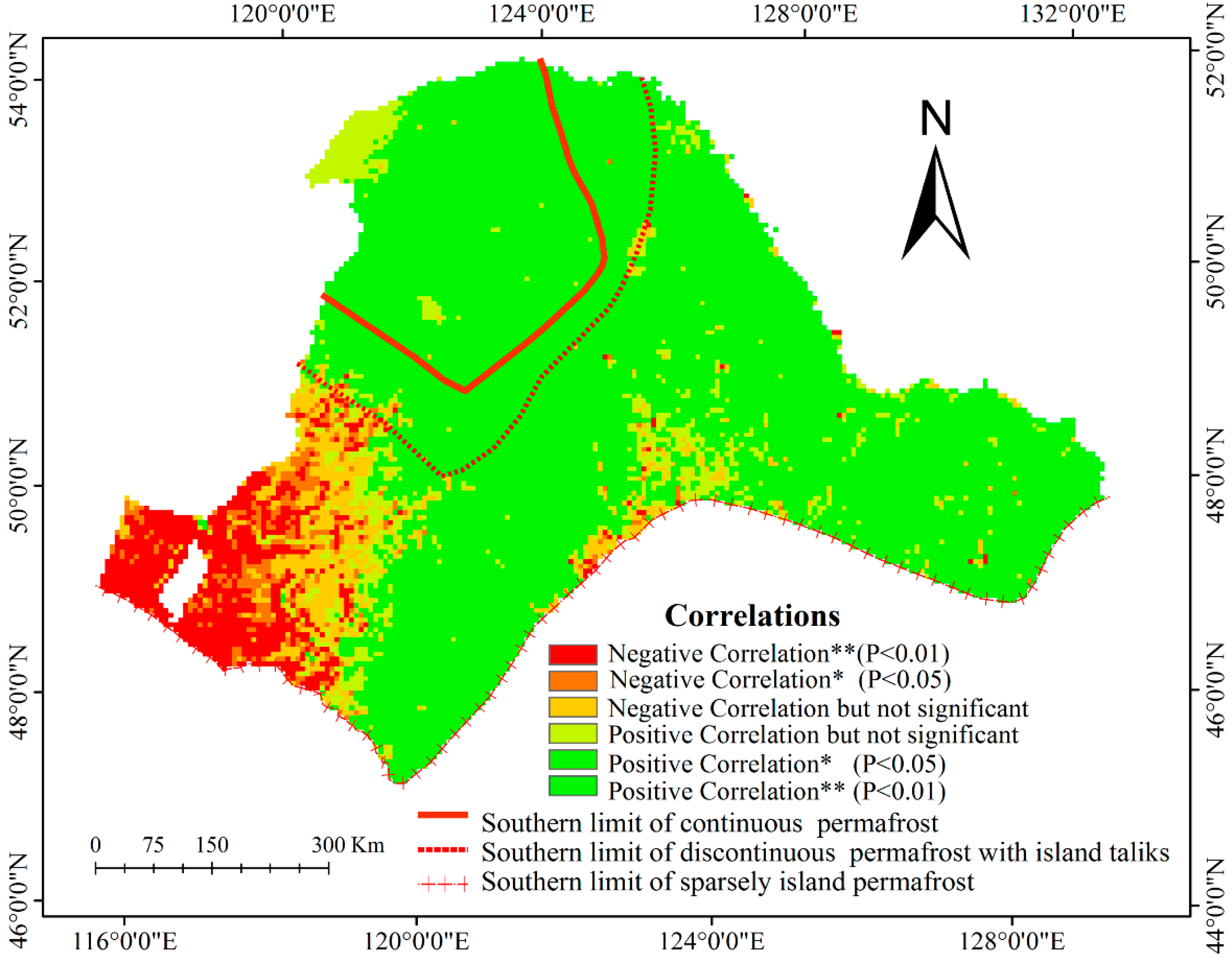
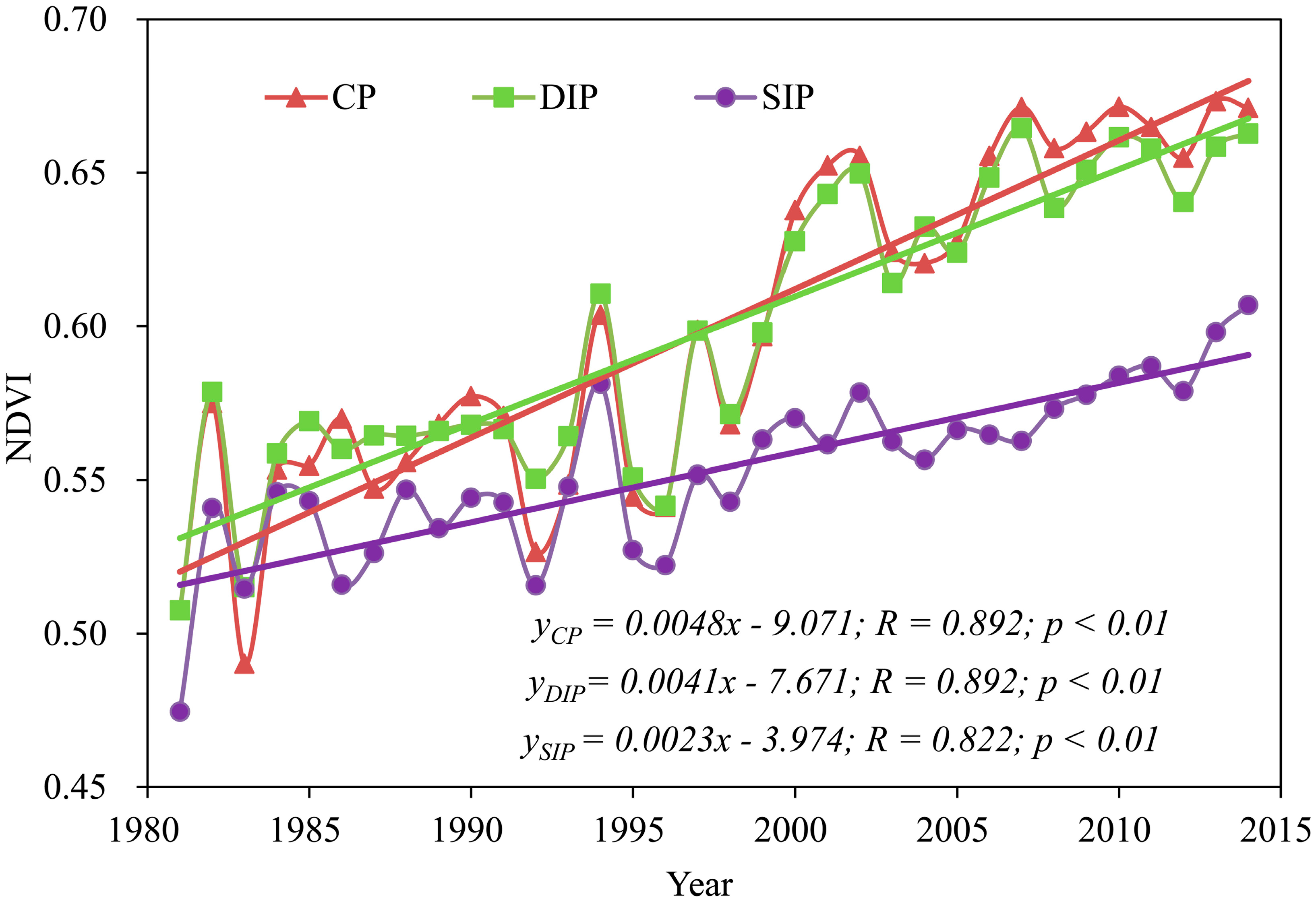
| Permafrost Types | Correlation Coefficients |
|---|---|
| CP | 0.754 ** |
| DIP | 0.821 ** |
| SIP | 0.718 ** |
© 2017 by the authors. Licensee MDPI, Basel, Switzerland. This article is an open access article distributed under the terms and conditions of the Creative Commons Attribution (CC BY) license (http://creativecommons.org/licenses/by/4.0/).
Share and Cite
Guo, J.; Hu, Y.; Xiong, Z.; Yan, X.; Li, C.; Bu, R. Variations in Growing-Season NDVI and Its Response to Permafrost Degradation in Northeast China. Sustainability 2017, 9, 551. https://doi.org/10.3390/su9040551
Guo J, Hu Y, Xiong Z, Yan X, Li C, Bu R. Variations in Growing-Season NDVI and Its Response to Permafrost Degradation in Northeast China. Sustainability. 2017; 9(4):551. https://doi.org/10.3390/su9040551
Chicago/Turabian StyleGuo, Jinting, Yuanman Hu, Zaiping Xiong, Xiaolu Yan, Chunlin Li, and Rencang Bu. 2017. "Variations in Growing-Season NDVI and Its Response to Permafrost Degradation in Northeast China" Sustainability 9, no. 4: 551. https://doi.org/10.3390/su9040551






